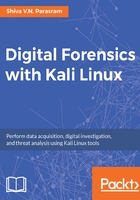
Summary
Congratulations! You made it to the end of the first chapter. Before we jump into the second chapter, let's have a look at what was just covered.
We saw that digital forensics is still a relatively new field, although forensic science has been around for a very long time, as far back as the early 1900s. Although digital forensics may have only been on the scene since the early 2000s, as a science, we have certain best practices, procedures, and standards, such as those created by the ACPO and SWGDE, to adhere to. These maintain accuracy and the integrity of both the findings and the actual evidence when carrying out investigations, whether as an amateur or professional Digital Forensic Investigator.
Some of the commercial tools mentioned were EnCase, FTK, and Magnet Forensics. Many of the open source tools available are made for Linux-based distributions and can be downloaded inpidually, but many are readily and easily available within certain Forensic and Security Operating Systems or distributions. Some of these distros are DEFT Linux, CAINE, and of course, Kali Linux; all of these are freely available for download at the links provided.
I hope this introduction to digital forensics was informative and fun for you. Now that we've gotten a foundation of forensics, let's go deeper into Kali Linux as we learn how to download, install and update Kali in Chapter 2, Installing Kali Linux. See you on the next page.